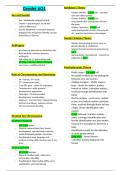Kohlberg’s Theory
Gender AO1
- Gender Identity – 2 years old – can label
Sex and Gender own and others gender
- Gender Stability – 4 years old -
- Sex = biologically assigned at birth
understands their own gender will stay
- Gender = psychological, social and the same
cultural differences - Gender Constancy – 6 years old –
- Gender Dysphoria = mismatch between understand gender remains the same for
biological sex and gender identity causing all – searches to reinforce stereotypes
discomfort or distress
Gender Schema Theory
- Gender stereotyping starts as soon as
Androgyny gender identity is established
- Schema formed and directs behaviour by
- A balance of masculine an feminine traits
age 6
- Bem Sex Role Inventory measure
- Ingroup better remembered – schema for
androgyny
outgroup at age 8
- Self-rating on a 7-point rating scale
- 60 traits – 20masc, 20fem, 20neutral
- Low score = undifferentiated
Psychodynamic Theory
- Phallic stage = 3-6 years old
Role of Chromosomes and Hormones - Pre-phallic children do not distinguish
- XX = female, XY = male between men and women
- 23rd chromosome pair - Oedipus complex – phallic stage in
- Y has SRY gene - codes for androgens boys – desire for mother, jealous
- Testosterone = male prenatal hatred for father, castration anxiety,
development, aggression resolved through identification with
- Oestrogen = female prenatal father
development, menstruation - Electra complex – penis envy, mother
- Oxytocin = love hormone, released during
is love rival, believe mother castrated
intimacy and labour, reduces cortisol
them, resolved through desire to have
(stress), promotes bonding
a baby, drives identification with
mother
- Freud believed castration anxiety
Atypical Sex Chromosome made a stronger identification and
Klinefelter’s Syndrome female identification was also weaker
because it’s secondary to desire for a
- XXY 1/600 males
baby
- Physical: reduced body hair, breast
development, rounded body contours, - Identification leads to internalisation
underdeveloped genitals, clumsiness of same gender parent
- Psychological: poor language and - Little Hans – feared horses –
problem-solving skills, shyness, loss of sex castration anxiety displaced onto
drive horses
Turner’s Syndrome
- X0 1/5000 females
- Physical: webbed neck, shied torso,
narrow hips, infertility
- Psychological: high reading ability, poor
spatial skills, social immaturity





